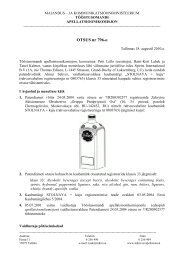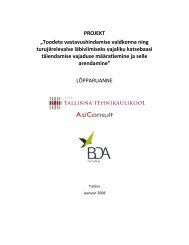Feasibility study for an Estonian Materials Technology Programme
Feasibility study for an Estonian Materials Technology Programme
Feasibility study for an Estonian Materials Technology Programme
Create successful ePaper yourself
Turn your PDF publications into a flip-book with our unique Google optimized e-Paper software.
77<br />
<strong>Feasibility</strong> <strong>study</strong> <strong>for</strong> <strong>an</strong> Estoni<strong>an</strong> <strong>Materials</strong> <strong>Technology</strong> <strong>Programme</strong><br />
4. Conclusions <strong>an</strong>d recommendations<br />
Technologies close to market entry<br />
Technologies <strong>an</strong>d comp<strong>an</strong>ies close to market entry are very import<strong>an</strong>t <strong>for</strong> the success of Estoni<strong>an</strong> materials<br />
technology in the short term<br />
The comp<strong>an</strong>ies, however, are not that interesting from technology tr<strong>an</strong>sfer point of view as they are<br />
focusing all their ef<strong>for</strong>ts on trying to commercialise their main product.<br />
Comp<strong>an</strong>ies with technologies in this group typically need the following:<br />
Investments in final phases of product development (public/private)<br />
Investments in establishing production (private)<br />
Highly skilled team in technology <strong>an</strong>d business<br />
Business knowledge of technology commercialisation <strong>an</strong>d good international contacts (especially in<br />
the case of materials technologies)<br />
Dedicated experts needed, because this knowledge seldom exists solely in the technology or business<br />
developers<br />
With good support from private investors, public sector, highly determined <strong>an</strong>d skilled team there is a<br />
potential to grow new success stories from comp<strong>an</strong>ies close to market entry in 3-5 years<br />
These may very well become comparable to e.g. Skype<br />
On the other h<strong>an</strong>d they may turn out to be worthless<br />
The first phase to get technologies to market is make prototypes. This is a necessary development phase<br />
very often <strong>for</strong>gotten by public funders. Dedicated funding <strong>for</strong> prototyping is needed.<br />
Prototyping is the next step after <strong>an</strong> R&D project has successfully ended. Without a prototype you c<strong>an</strong>not<br />
sell your idea further to investors. Prototype funding should especially be directed to newly started<br />
high-tech comp<strong>an</strong>ies who need evidence of the per<strong>for</strong>m<strong>an</strong>ce of the product. In materials technology<br />
development projects in particular prototypes c<strong>an</strong> be expensive to make.<br />
Universities could also be encouraged to make “less real” prototypes to check if their ideas work in<br />
reality.<br />
The size of investment needed <strong>for</strong> a materials technology innovation to enter the market is usually very<br />
much higher th<strong>an</strong> <strong>for</strong> <strong>an</strong> ICT innovation, the initial investment being in the order of 1-2Me. A small<br />
country c<strong>an</strong>not af<strong>for</strong>d m<strong>an</strong>y of these <strong>an</strong>d international money has to be attracted too. When calculating<br />
the benefit of the investment the potential amount of working places it produces should be very high on<br />
the scale of criteria.<br />
Applied research<br />
Technologies in the applied research phase typically have the highest potential <strong>for</strong> technology tr<strong>an</strong>sfer<br />
Carbon based n<strong>an</strong>omaterials<br />
Adv<strong>an</strong>ced materials <strong>for</strong> e.g. sensors use<br />
N<strong>an</strong>omaterials in general<br />
Photovoltaic materials<br />
Adv<strong>an</strong>ced coatings <strong>for</strong> metals industry<br />
There is currently a clear mismatch between materials technology inventions in Estonia <strong>an</strong>d requirements<br />
<strong>an</strong>d capabilities of the industry<br />
Very m<strong>an</strong>y adv<strong>an</strong>ced materials inventions do not arise interest among industrial comp<strong>an</strong>ies, which is<br />
very typical internationally too.<br />
One path <strong>for</strong> utilising these technologies is to establish spin-off comp<strong>an</strong>ies, this has already happened<br />
with m<strong>an</strong>y close to market entry technologies but requires highly determined people with<br />
business knowledge, <strong>an</strong>d is more of <strong>an</strong> <strong>an</strong>omaly th<strong>an</strong> a practice<br />
Another path is technology tr<strong>an</strong>sfer to international org<strong>an</strong>isations, which does not currently exist<br />
on a broader level in Estonia<br />
To speed up the adaptation, the technologies should be developed together with industry partners.<br />
Highest potential <strong>for</strong> technology tr<strong>an</strong>sfer exist in the metals industry coatings segment<br />
Large comp<strong>an</strong>y base <strong>an</strong>d university research base me<strong>an</strong> that there is both supply <strong>an</strong>d potential<br />
dem<strong>an</strong>d <strong>for</strong> the technology<br />
Huge global market me<strong>an</strong>s there is a lot of room <strong>for</strong> adv<strong>an</strong>ced coatings (e.g. n<strong>an</strong>ocoatings) in the<br />
market in various niche areas that c<strong>an</strong> the existing industrybut especially new spin-off comp<strong>an</strong>ies





